The BEST Trick to Prevent Weeds in Flower Beds
Wouldn’t it be nice to prevent weeds in flower beds without a lot of work?
It is possible with this eco-friendly trick – create a weed barrier using cardboard and wood mulch to prevent weeds from growing in the first place!
Also called “sheet mulching”, this simple garden bed prep can make weed-free flower beds a reality! I swear by this method for all my native plant garden beds.
Have weeds? Download my FREE 10 Common Texas Weeds PDF! I want to help you identify the most common weeds and provide you with information about their benefits (or lack of benefits) so you can make good decisions before you pull.
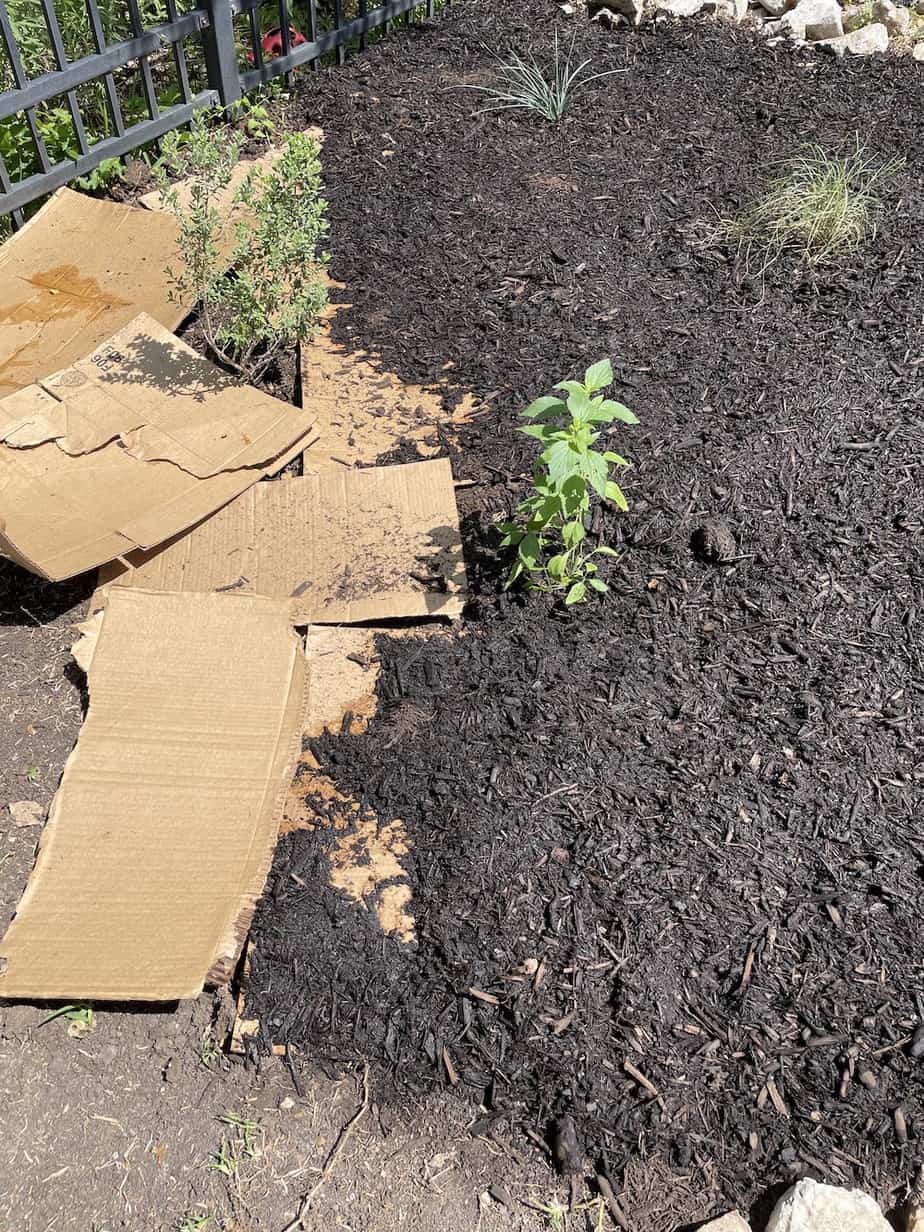
This post contains affiliate links. See our full disclosure.
I prefer sheet mulching with cardboard and mulch over using any type of herbicide or weed killer in my native plant garden. Let’s work together to minimize the use of chemicals and use more organic methods for weed control!
Prevent Weeds in Flower Beds with Cardboard and Mulch
Preparing your garden beds with cardboard and several inches of mulch is the most effective way I have found to keep weeds out of a new bed. Not only does it smother any current weeds, it creates a physical barrier to prevent future weed growth. It prevents a bare soil surface which is an invitation for weeds to grow.
You can use this method to:
- Prep a new flower bed or vegetable garden
- Smother grass to convert it into a garden bed
- Control weeds in an existing flower garden, landscape beds, or raised bed
Why landscape fabric doesn’t work
A fabric weed barrier is one of the most widely used weed barriers by landscaping companies, but I have found it to be very lacking.
I have seen weeds and Bermuda grass grow right though cheaper landscape fabric, making it impossible to weed without ripping the fabric. Weeds will also find any gaps between sheets of landscaping fabric.
Landscape fabric also isn’t the best way to prevent weeds in a flower bed where you want to add annuals or regularly swap out plants. Cutting holes through the fabric to add new plants can turn into a mess.
From my experience, cardboard works much better than traditional landscaping fabric for keeping out weeds. It also is more natural, slowly breaking down organic material into the soil over time.
5 Simple Steps to Prevent Weeds in Flower Beds
You can do this method to prep a new flower bed or to eliminate weeds around around existing plants in your garden bed.
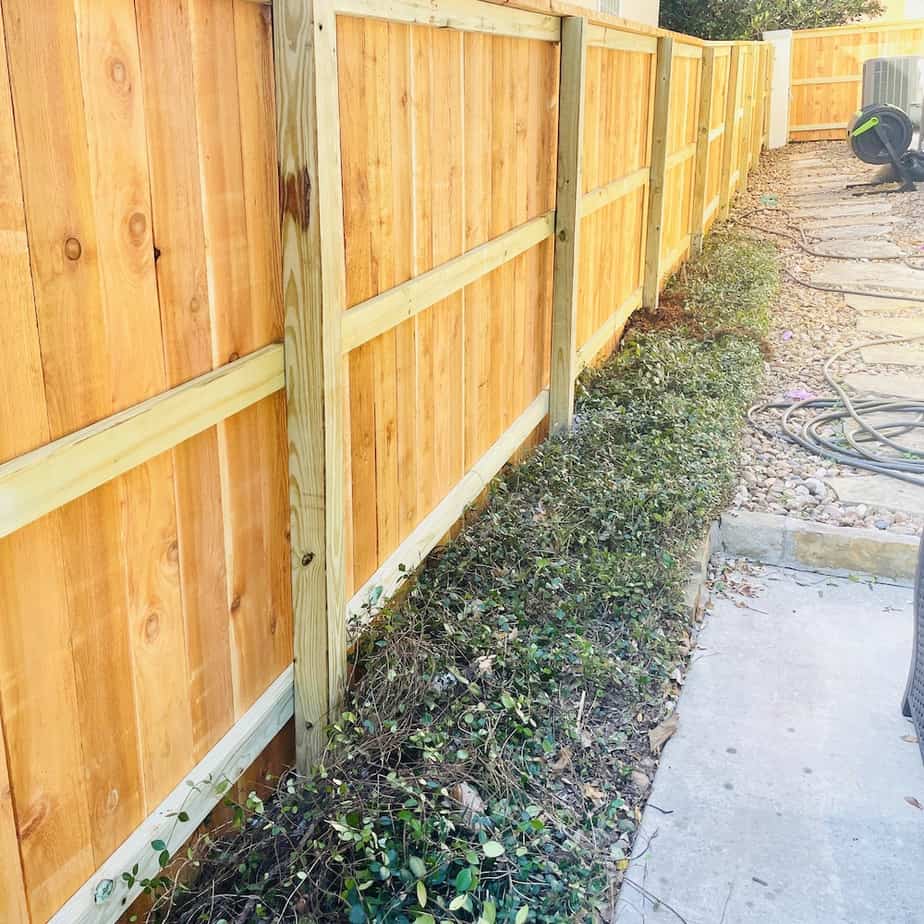
1. Collect lots of cardboard boxes
Start collecting cardboard now – this is a good use for all those Amazon boxes! For this method you want to use plain cardboard boxes with any packing tape removed. Avoid boxes with glossy printing on the top of the cardboard. Ask your neighbors or local grocery store or school if they have boxes you can use.
2. Remove large weeds or any unwanted plants
I like to weed the area as much as I can beforehand, but you don’t have to. The cardboard and mulch should smother any existing weeds and prevent them from growing back.
However if you have large weeds in the area, you may want to mow them down close to the ground, or dig them up. My favorite tool for digging up large weeds is the Root Slayer shovel. Its serrated edges cut through the soil easily to remove a plant and get out all the roots.
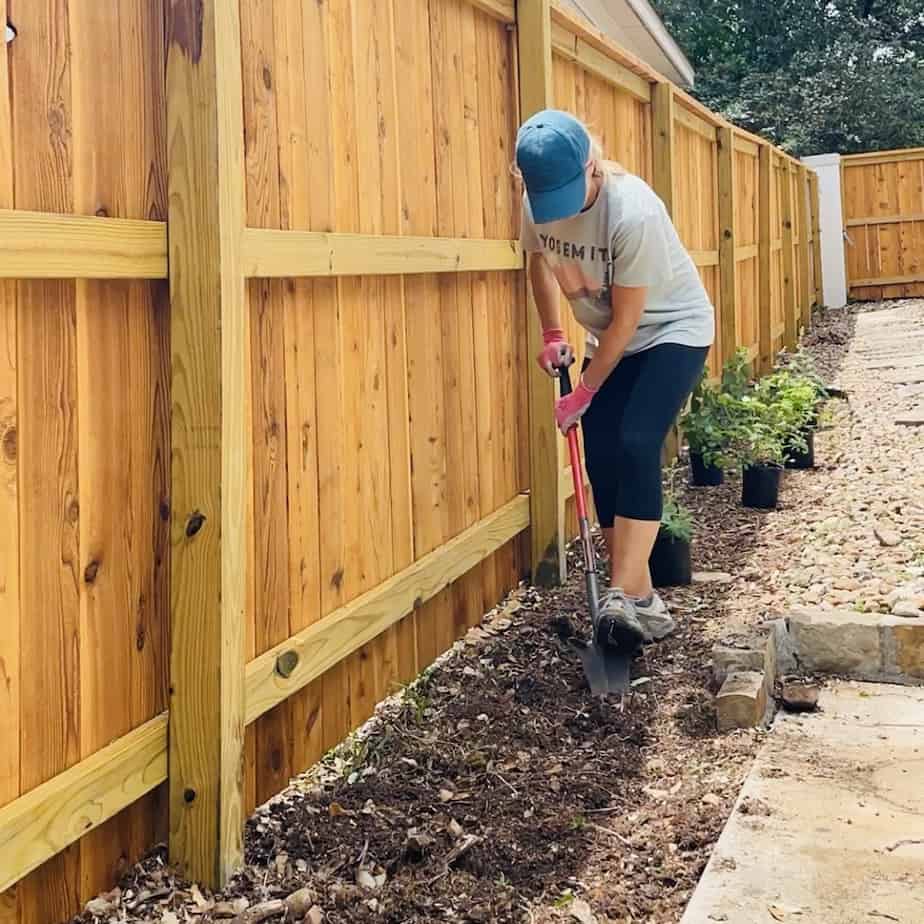
3. Cover planting area with boxes
Flatten and slightly overlap the boxes, covering the entire planting area. For an even thicker weed barrier, you can add two layers of cardboard.
If you already have some plants in your flower bed that you want to keep you can position the cardboard around them. To cover the areas right around the base of the plant you can use layers of newspaper instead of cardboard if that makes it easier.
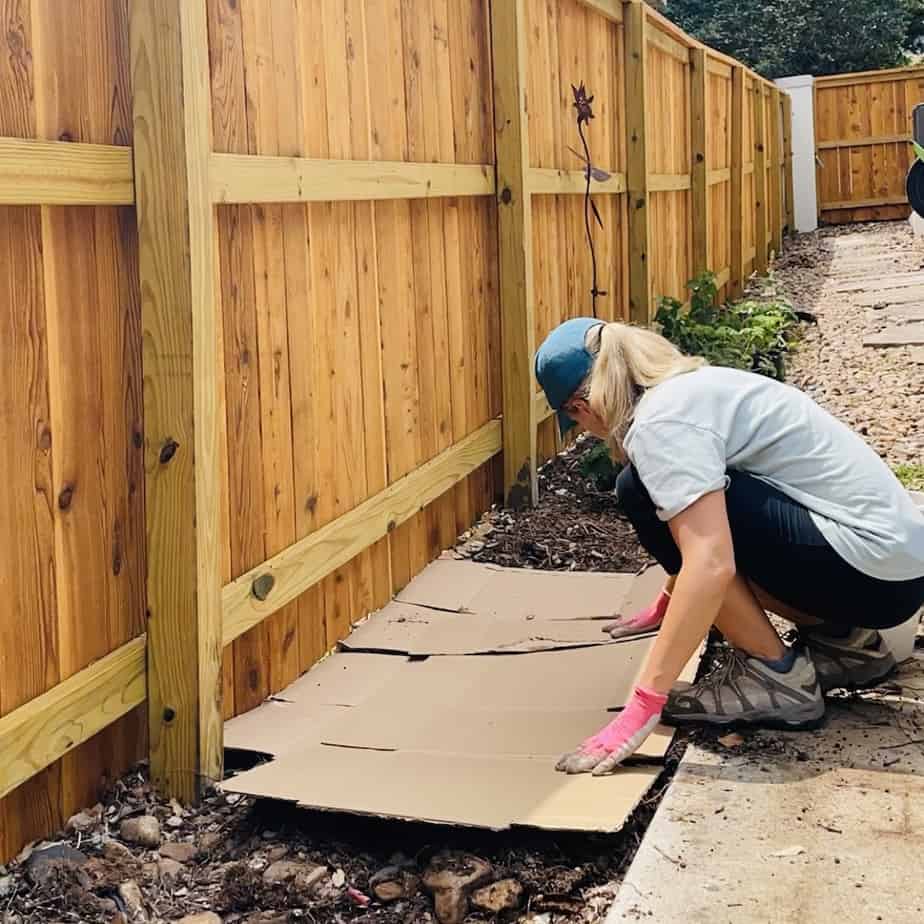
4. Add a thick layer of mulch
Once you have the cardboard down you want to cover it with a 3 inch layer of mulch. If you are adding mulch around existing flowers or other garden plants, you just want to keep the mulch a few inches away from the base of the plant. Too much mulch around the base of a plant can lead to disease.
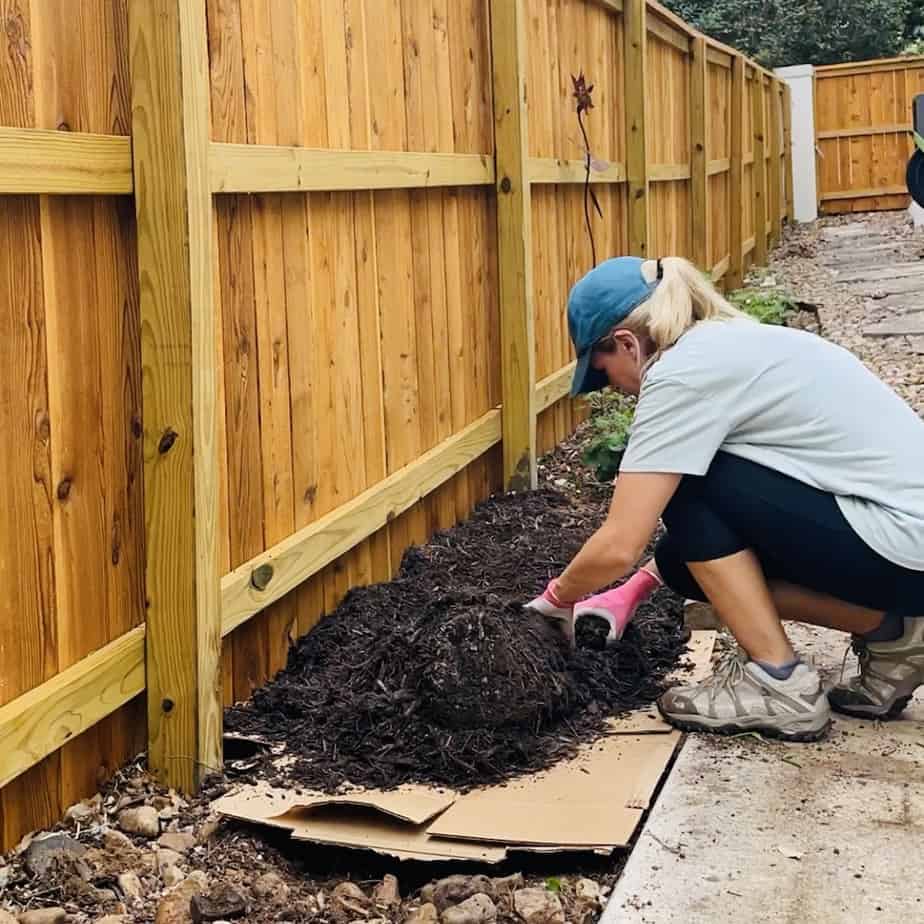
5. Water down well
Finishing by watering down down the mulch and cardboard barrier to hold it in place.
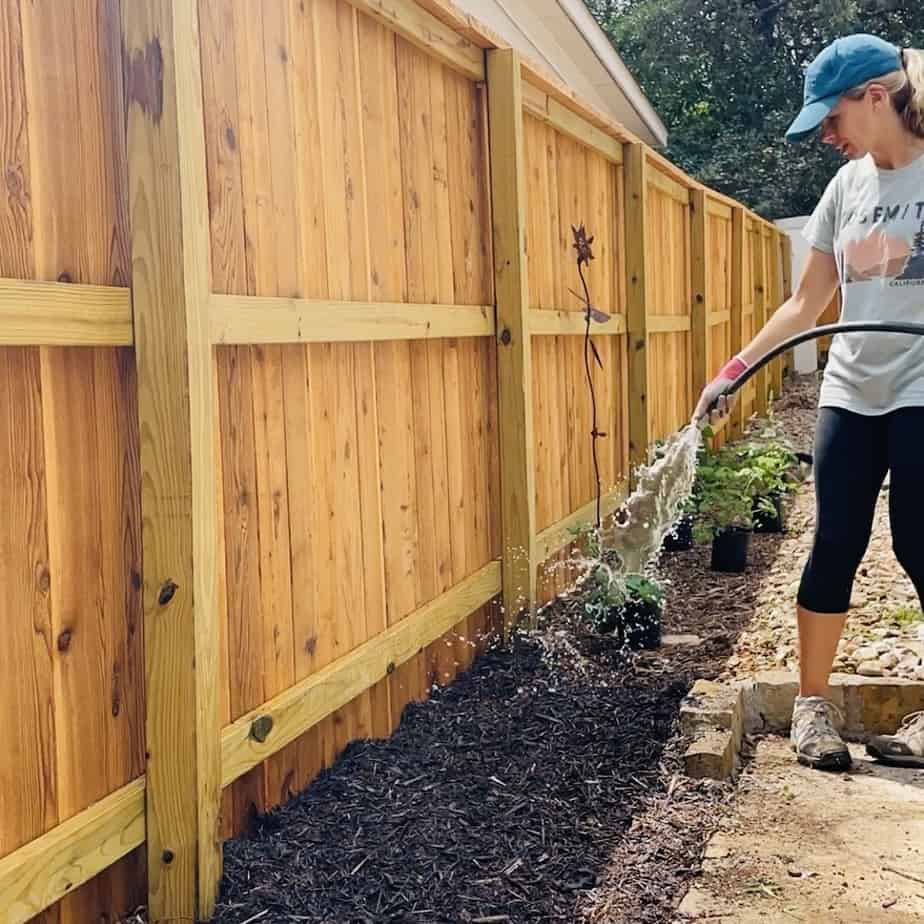
This method will keep weeds out for a the next year, but you may want to add a fresh layer once the cardboard layer has decomposed. As the cardboard breaks down it will add organic matter to the soil.
How to Add New Plants with a Weed Barrier
If you added cardboard and mulch directly over weeds and/or grass, you may want to leave it in place for several months before adding any flowers or other garden plants. This will give time for the grass and weeds to be killed before digging through the cardboard weed barrier.
When you are ready to add a new plant, just push the mulch aside in the area you want to plant it and use a garden knife like this hori hori knife to cut out a hole in the cardboard and insert your plant.
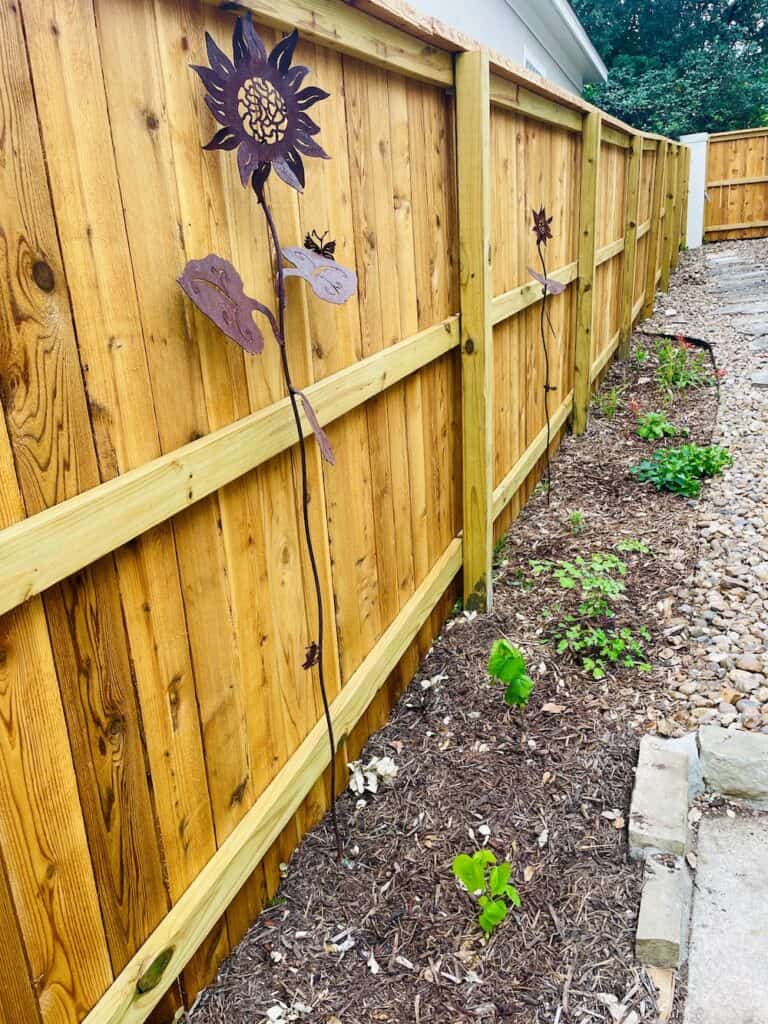
Converting Turf Grass to a Garden Bed
If you are converting an area with turf grass to a garden bed, you first want to research whether this approach will work well with the type of grass you have.
In particular, Bermuda grass (Cynodon dactylon) often finds a way to come back no matter what weed barriers are placed on top of it, whether it is cardboard, landscape fabric, or black plastic sheeting. You don’t want a situation where you have Bermuda growing on top of your cardboard and mulch.
Unfortunately, Bermuda grass is the one grass I know of that you may have to resort to using chemical hebicides to effectively remove it. If not, you have to stay very vigilant to prevent it from taking over your garden beds. Here are some options to consider for controlling Bermuda grass.
To convert an area of St. Augustine grass (Stenotaphrum secundatum) to a garden bed in our yard, we used a cultivator to do a light till of the soil to break up the St. Augustine runners. We raked up as much as we could before sheet mulching.
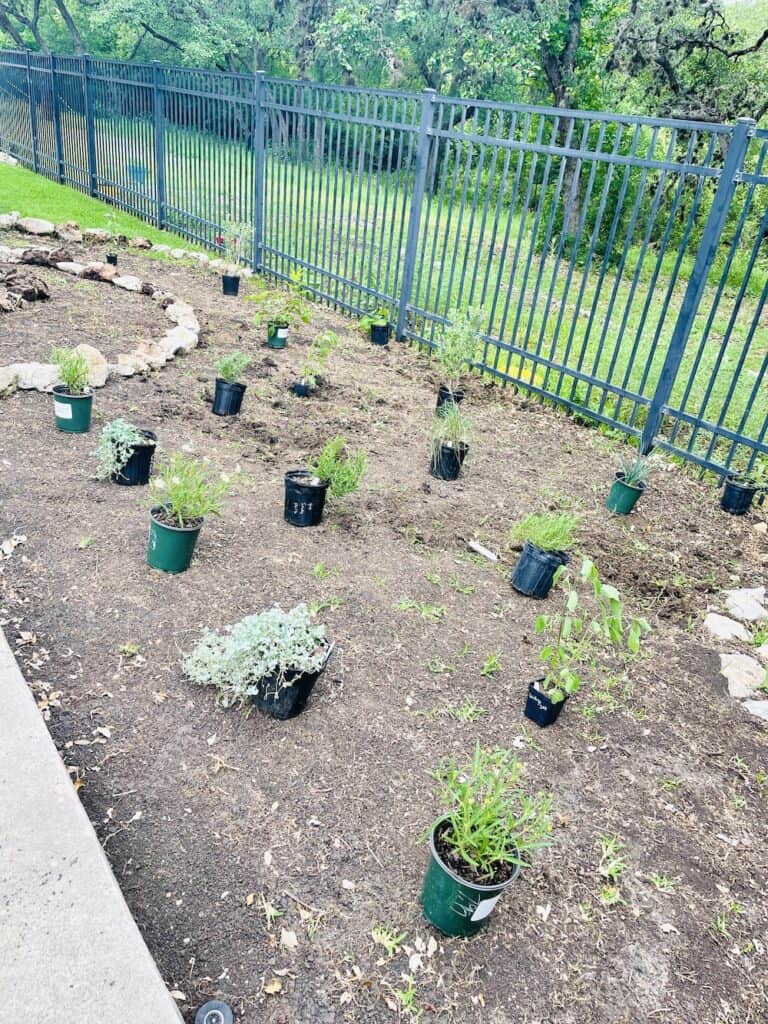
Different Types of Mulch for Your Flower Beds
In addition to being a weed preventer, mulch in your garden can help conserve moisture at the base of the plants. It also has an aesthetic appeal, contributing to a beautiful flower bed.
Wood mulch
While you can find hardwood mulch or bark mulch in a variety of colors, I recommend organic mulches using wood chips that haven’t been dyed. Ideally you want to find wood mulch from local native trees in your area. I prefer a double shredded wood mulch to a single grind mulch, but the single grind will take longer to decompose.
If you are covering large areas with mulch, you can look into getting free or low cost mulch from your municipality. For instance, my city of San Antonio, Texas offers fine ground mulch for $0.03 a pound through its Brush Recycling Center.
FYI – I have heard that these mulches can tend to have more weed seeds than commercially purchased mulch. But it may be worth it if you are covering a large area and are looking to save money.
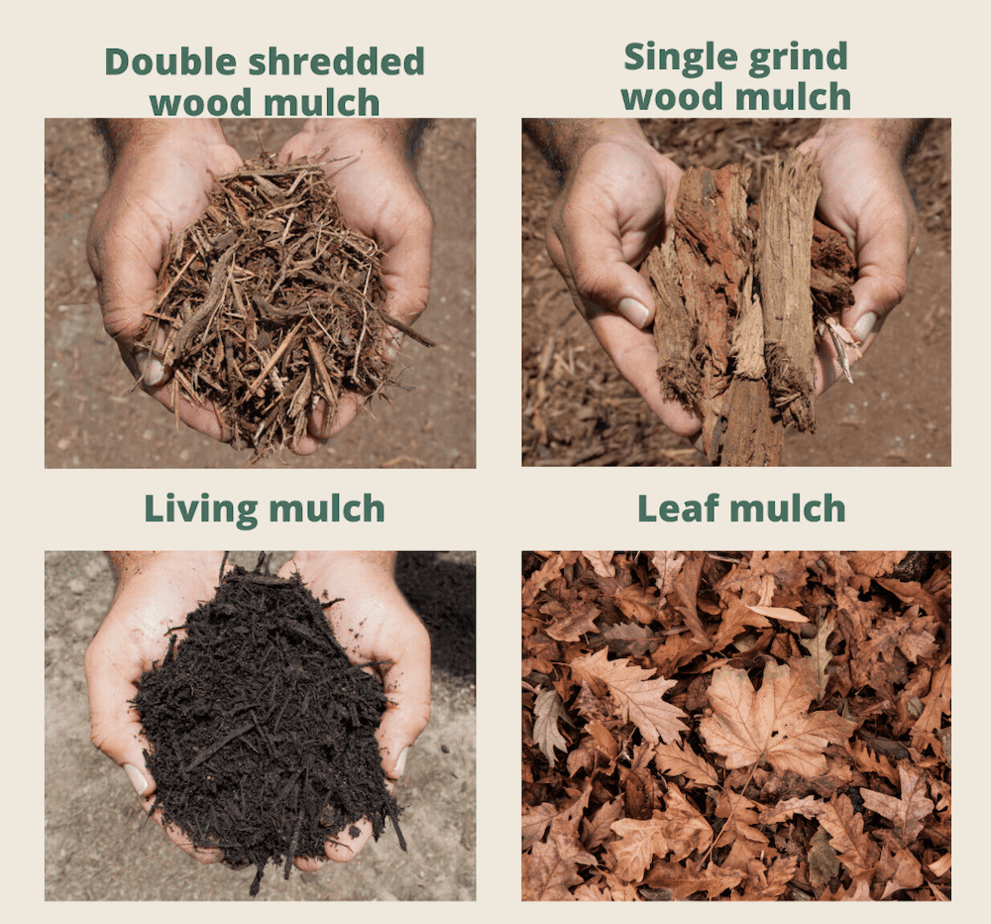
Living Mulch
Living mulch is a term for mulch that is a mix of compost and hardwood. It can also be called composted mulch. This is a great way to add more nutrients into your flower bed. I have had success using living mulch over cardboard in my native plant garden.
Leaf Mulch
I love using leaf mulch in my garden. However, I wouldn’t recommend using it directly over cardboard, as it doesn’t hold down the cardboard as well as hardwood mulch.
Leaves have a tendency to move around more in a garden bed with wind and rain. But that doesn’t mean they aren’t a great supplement to your garden! I like to add a layer of leaves to my flower beds that have already had the cardboard and mulch barrier down for awhile.
Here in San Antonio, our live oak trees drop their leaves in early spring, making the perfect spring mulch for my garden!
Grass clippings
Grass clippings are another great option for mulching your garden. You want to make sure the clippings are dry before adding them to your garden. Check out these tips for using grass clippings as mulch.
How to Identify Garden Weeds
Even if you’ve done your best to prevent weeds in flower beds by sheet mulching with cardboard and mulch, some weeds will find a way to make it through.
However, before you are quick to pull, it is helpful to know what exactly you are pulling! It could be a baby plant of one of your perennial flowers that has spread.
Knowledge is power when it comes to being a purposeful gardener. Rather than just assume a plant is a weed, take some time to identify it and learn about it. You may decide you want it in your garden after all!
An easy way to identify common weeds is with a plant ID app. I like to use iNaturalist to identify plants.
How to Pull Weeds Effectively
Many plant roots can be tricky to pull. It is easier to pull young weeds with more shallow roots than larger weeds with deep roots, so get them when they are new! You also want to weed plants before they go to seed. A great time to weed is after a rain when the ground is soft.
You also want the right tool for the job…
The Best Garden Weeder Tool!
I’ll say it again – this hori hori knife is the only tool you’ll ever need for small weeds! It is the tool I use most in my garden bag and puts a traditional garden trowel to shame!
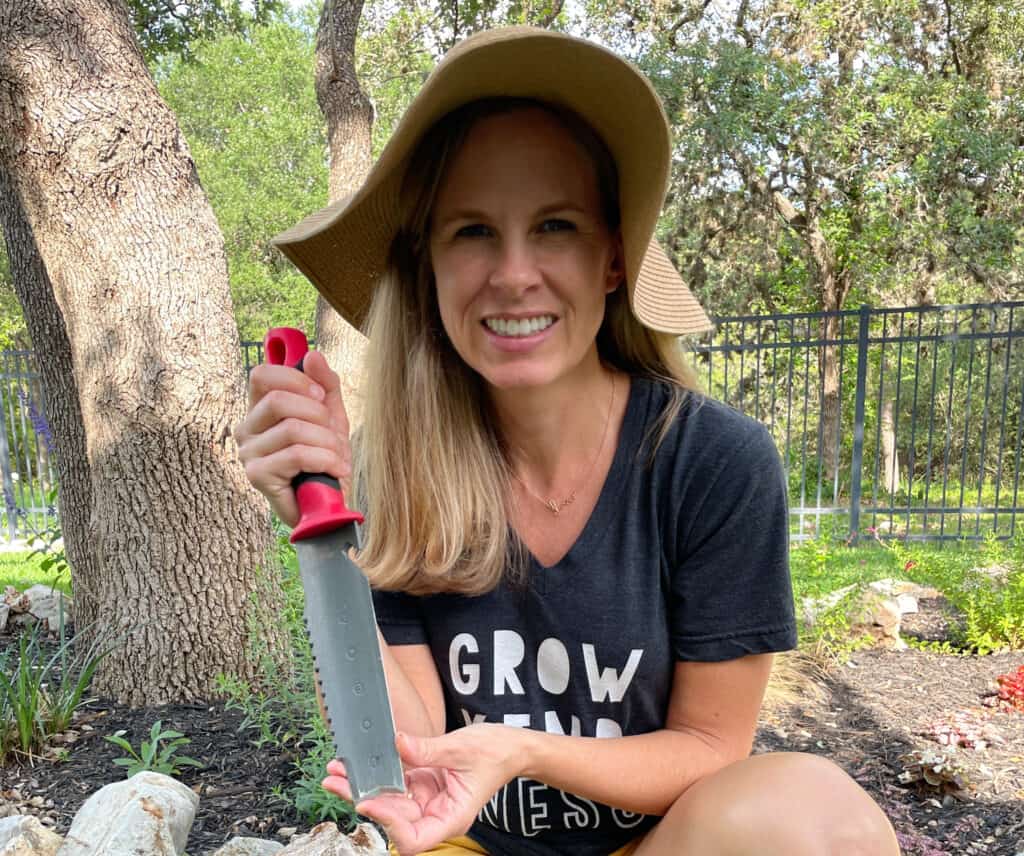
The cardboard and mulch should do the trick to prevent weeds in flower beds. When paired with the hori hori knife, weeds don’t stand a chance in your garden bed!
Download the Free Common Texas Weeds PDF
Download this FREE PDF to help you identify the weeds in your yard. It contains a photo and information each of them.
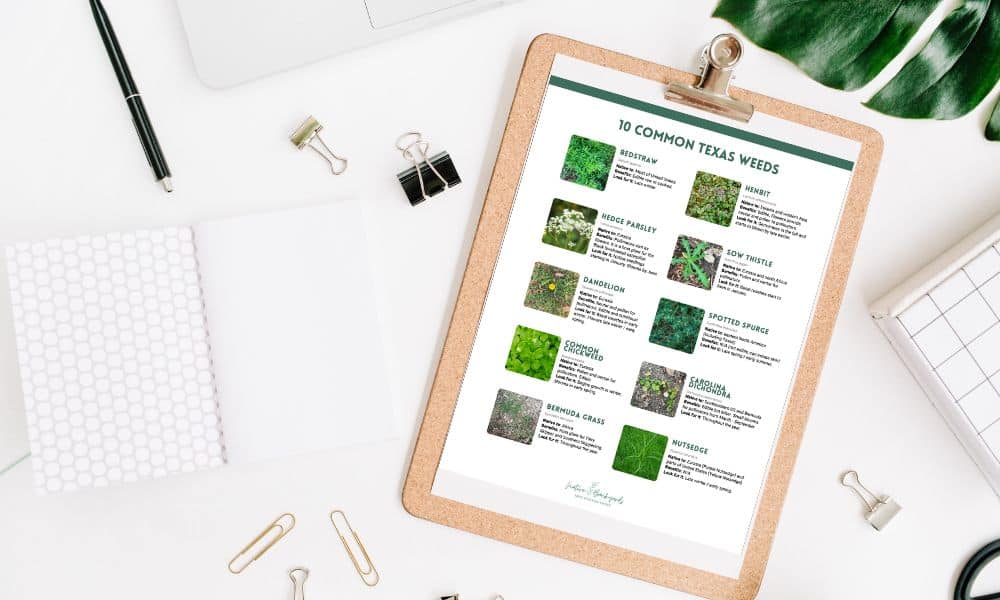
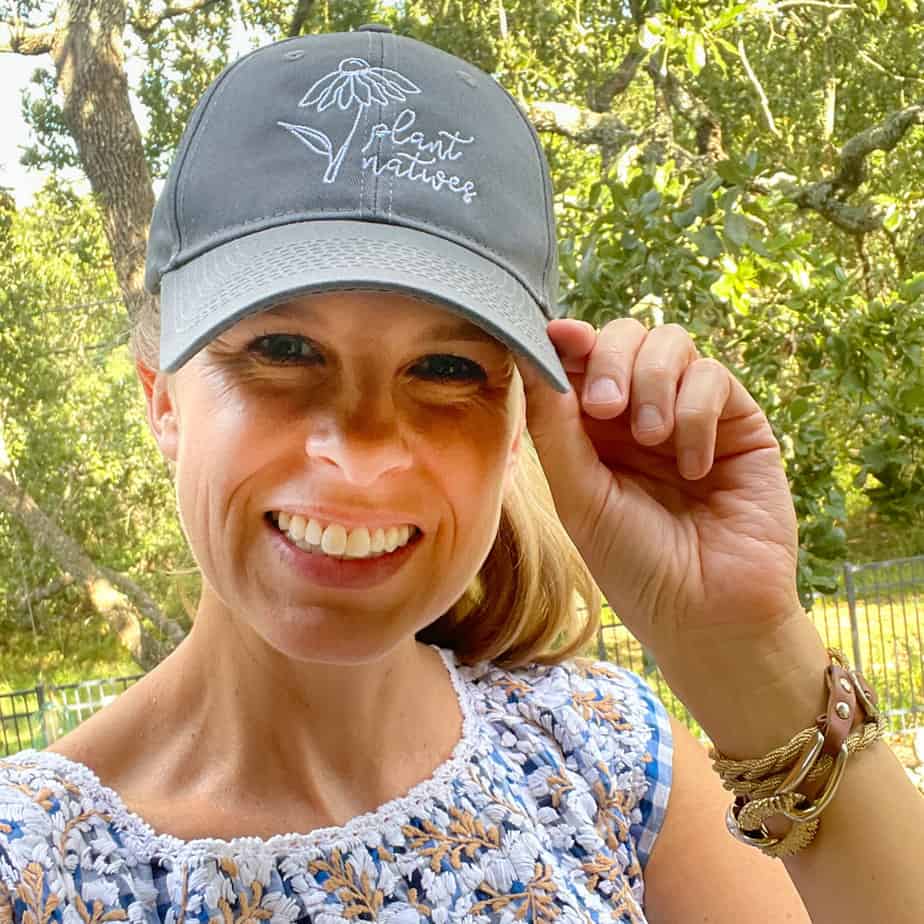
Welcome to Native Backyards! I’m Haeley from San Antonio, Texas, and I want to help you grow more native plants.
I have seen firsthand how the right plants can bring your yard to life with butterflies, bees, and birds. I’ve transformed my yard with Texas natives and I’m excited to share what I’ve learned with you.
Join my newsletter here! – each week I’ll send you helpful tips to make your native plant garden a reality!
Want to learn more about me and my garden? Check out my About page!
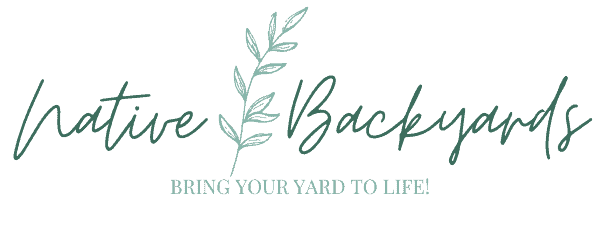
I have a butterfly garden. It’s a work in progress. I am replacing the grass with cardboard and Floramulch on top of the cardboard. My question is how to allow the plants that spread via seed drops to do so, in spite of the cardboard and mulch? For example, how will the sage reproduce if the cardboard and mulch are in the way?
Hi Penny, that is a good question and something I will clarify in the post. You are correct that this method doesn’t work as well with self seeding annuals, as the seeds need more direct soil contact to germinate. A couple thoughts – if you are putting down the cardboard and mulch now (in the spring), that may give them enough time to break down over the summer so when your plants drop their seeds in the fall there will be less of a barrier. Perhaps sprinkle some compost and soil on top towards the fall, or push back the cardboard and mulch in those areas before seeds drop.
Can I use gravel instead of mulch?
You can use gravel. I used river rocks on top of cardboard in part of my landscaping and have had success. The cardboard will smother and kill any existing weeds underneath. The only caveat is that the cardboard will break down over a year or so and eventually new weed seeds could settle in between the rocks and you’ll need to do some weeding.
Hi Haeley – Will this work for rocks too instead of mulch? I was planning to put down a rock layer – no plants, but wanted to put something under to prevent the weeds growing through! This might work well – any thoughts on that?
Hi Gina, thanks for your question. Yes, this does work with rock! I used it in my own yard last fall with river rocks on top to smother and kill some Asian jasmine ground cover in one of my landscaping beds. So far, so good. It should successfully kill any existing weeds in the soil. However, the cardboard will break down over a year or two, so eventually new new weed seeds could find soil between the rocks over time and germinate. This would happen with cardboard and mulch too. It’s just easier to refresh mulch than it is to move rocks out of the way to add a new layer of cardboard. Definitely a cardboard barrier under rock is better than no barrier. I would give it a try!
I have a conundrum, There is irrigation in the garden bed. I am fighting invasive elm tree saplings. I have a vitex and some Pride of Barbados I need to water. I want to use the cardboard and mulch method along with an industrial strength fabric to block the saplings. What should be done about the irrigation “soaker” lines under the old soil? Will the moisture come up through the new cardboard and mulch ? Or do I need to get an irrigation service to replace the underground system with something that lays on top?
Hi Jo, thanks for your comment. I have seen soaker hoses work great under a few inches of mulch, so I think you would be fine covering yours with a layer of cardboard and mulch. I found a few examples online of people pairing soakers with cardboard and mulch. Here is a helpful article I found: https://landscapingplanet.com/can-a-soaker-hose-be-buried/.
Steps to stop weeds in flower beds. Step 1: dig the small areas where you will plant the flower beds. Step 2: plant the flowers. Step 3: use newspaper to cover the soil. Step 4: mulch the flower beds. Step 5: frequently check and remove all the weeds in your flower beds.
I really hate weeds in our garden and I’m starting to lose hope that I can get rid of them. Glad I saw this post and learned a lot from it. Thank you!
Thank you for all of your knowledge .
I HAVE WEED PROBLEM IN MY CALIFONIA FLOwER BED. I also recently had a hip replacement surgery and i have a torn rotator cuff. So back to the garden….I was thinking of a rototiller. Using it once or twice,raking the weeds, and then after reading all of these tips, putting down some cardboard and black mulch. I normally prefer to use a pitch fork but my shoulder cant handle anymore injury. As i continue to read a rototiller is a bad thing. Any ideas
Hi Annette, using a rototiller once or twice to break up the weeds is not necessarily a bad idea in your situation. While rototilling the soil regularly is not recommended, I think it is fine to do it once to get control of weeds. Adding cardboard and mulch afterwards will go a long way to keeping them at bay.